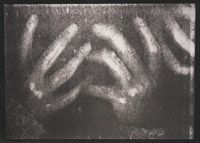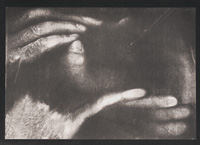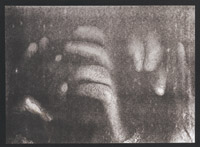Á
propos xerox
When
xerox finished its bureaucratic /multiplication in offices/ and
political /samisdat/ career in Hungary, it was the time to go
on the stage for the xerox machine. The new media has
forced the artists to apply its possibilities in their works.
Amongst others, the two artists exhibiting in the French Institute
of Budapest, Jenô Detvay and Peter Herendi, knowing nothing
about each other have started to work with xerox in Paris and
Budapest in order to build in the new machine to their artistic
circle of means. This is the first time they put on show their
works which were done nearly at the same time, at the midst of
the eighties. These works previously could have been seen only
by friends and some artists, never presented to the public. Their
mutual aim was to discover, show and reinterpret the human body
and its parts by the help of the machine. After the basically
common start, they have chosen technically different methods to
get the last shape of the artwork. Though both of them have made
the body the object and subject of their works, they have nothing
to do with body art, as they have approached the new media from
the point of view of graphics and photo art.
Detvay emphasizes the details, photographs the selected slice,
then turns it to black-and-white polaroid 665, lets the films
to dry upon each other for 2-3 days, finally makes laser enlargements
to photo papers with the most up-to-date technology. His works
come to life from the contrasts of intention and chance, from
the game of controlled processes and accident. He never puts objects
to the drying films to create formations, contours, directs shapes,
opposites of light and shadow, because he does not want to regulate
the graphical character of the work. In his case there are different
motives in the pictures like the face, the hand, the mouth, a
wound, and all the details of these elements. There is no prettiness
in his works, it is about exact documentation and discovery by
the help of blow-up focusing on the landscapes and ditches of
the body, about stubble, hairs, pores of skin, finger-prints.
The motion is nearly futuristic, there are torsion's, lines of
waves, phases, UFO-like faces, vital and mask-like descriptions,
dynamics and frozen moments.
Herendi has chosen another way. He is not interested in enlargement
and details. He reproduces the xeroxes to 6x9 negatives. Then
he makes master-positives from these ones and enlarges them to
large-size negatives, which is the base of argentotypia. That’s
why his works are less scratchy in colors, he composes more lyrically
and softly. Herendi, though he has also taken shots about the
whole body, exhibits only hands at the present show. The cube
of the picture gives the whole sight. There are pictures standing
and in motion, too. The hand in rest starts to move, gives signs,
dances. It pets, saves and casts off, clasps to itself, shortens
and stretches, bands like a paw at the same time. The light of
the xerox fingers the hand, however, there are moments when Herendi
follows, what is more he precedes the ray of the light. I do not
know whether it was intentional or not, but one of his works reminds
me the print of Christ in the Shroud of Torino, while another
one directly refers to the horrors of Tsernobil.
The pictures are on show without any title, though they can be
easily identified, as they can be grouped or arranged in pairs.
Both of the artists’ technical knowledge is outstanding for
they apply differents tricks, covering nearly 150 years, from
the ancient age of photography to the most modern photographic
techniques. As professionals they are not at loss for a theme
or motive. At hem the hand is always „ near at hand".
by
Csaba KOZÁK
18 04 2001 Budapest
|
|
A xerox apropója
Amikor
a stencil befejezte bürokratikus /munkahelyi sokszorosítás/
és politikai /szamizdatok/ pályafutását
Magyarországon, akkor jött el a fénymásológép
ideje. Az új médium a mûvészek érdeklôdését
is felkeltette, így történhetett meg, hogy a
budapesti Francia Intézetben kiállító
két mûvész, Detvay Jenô és Herendi
Péter egymástól függetlenül, Párizsban
és Budapesten a nyolcvanas évek közepén
szinte egyszerre vette birtokba a fénymásolót,
hogy azt mûvészi tevékenységük eszköztárába
beépítsék. Munkáik most kerülnek
elsô alkalommal bemutatásra, a szûk baráti
és mûvészi körön kívül
a közönség még nem láthatta mûveiket.
Céljuk az volt, hogy az emberi testet, annak részleteit
fedezzék fel, mutassák be és értelmezzék
újra a gép segítségével. Az alapvetôen
közös indíttatás után viszont technikailag
más-más útját választották
a mûtárgy végleges formájának
elnyerése érdekében. Bár a testet tették
mûveik alanyává és tárgyává,
a body art-hoz közük nincs, az új médiumot
sokkal inkább a grafika és a fotómûvészet
szemszögébôl közelítették meg.
Detvay a xerox részleteit emeli ki, Leica kisfilmre fotózza
a kiválasztott szeletet, ezt átfordítja fekete-fehér
65-ös polaroid filmre, a filmeket egymáson hagyja összeérni,
száradni 2-3 napig, majd a legmodernebb digitális
technikával lézernagyításokat csinál
fotópapírra. Munkái a szándékosság
és az esetlegesség, az irányított folyamatok
és a véletlen játékából
alakulnak ki. Megtehetné, hogy tárgyakat helyez a
száradó filmre, formációkat, kontúrokat,
direkt alakzatokat, fényé s árnyék ellentéteket
hozzon létre, de a mû grafikusságát nem
kívánja irányítani. Nála különbözô
motívumok szerepelnek a mûveken, az arc, a kéz,
a száj, egy seb, illetve mindezek részletei. Semmi
szépelgés, pontos dokumentáció és
felfedezés a nagyítás által a test tájairól,
dombjairól és árkairól, borostáról,
szôrszálakról, pórusokról, ujjlenyomatokról.
Szinte futurista mozgás, torzítások, hullámvonalak,
fázisok, UFO-szerû arcok, életszerû és
maszkszerû leírások, dinamika és kimerevített
pillanatok. Herendi más utat választott. Nem nagyít
és nem részletez. A xeroxot 6x9-es negatívokra
reprodukálja. Az ezekrôl készült mesterpozitívokat
nagyítja nagyméretû negatívokra és
ez az argentotypia alapja. Így munkái színekben
is kevésbé karcosak, költôibben, lágyabban
fogalmaz. Herendi – bár az egész testet megörökítette
– a jelen kiállításra csak kezeket hozott.
A kép kockája a teljes látványt adja.
Vannak álló és mozgásban lévô
képek, a nyugalmi állapotban lévô kéz
elszabadul, jeleket ad, táncot jár. Egyszer simogat,
óv és eltaszít, önmagába kulcsolódik,
rövidül és megnyúlik, karomszerûen
meghajlik. A xerox fénye letapogatja a kezet, de van, ahol
Herendi követi, sôt megelôzi a fény pászmáját.
Nem tudom, hogy szándékos-e, de az egyik munka a Torinói
Lepel Krisztus lenyomatára emlékeztet, máshol
viszont direkten idézi meg Csernobil borzalmát. A
képek cím nélkül vannak kiállítva,
hiszen anélkül is azonosíthatóak, ahogy
párba és sorozatba rendezhetôek mindkét
mûvész munkái. Közös bennük az,
hogy technikai felkészültségük lenyûgöz_,
a fényképezés ôskorától
a mai nap legmodernebb fényképészeti eljárásig
képesek közel 150 évet átölelô
fortélyokat beépíteni munkáikba. És
mint profik tudják, hogy nem kell a szomszédba menni
témáért, motívumért. Náluk
a kéz „mindig kéznél van".
KOZÁK Csaba
18 04 2001 Budapest
|
|
A propos photocopie
Le déclin de la carrière bureaucratique (polycopie
dans les bureaux) et politique (dissidence) du stencil en Hongrie
signifia l¹avènement de la photocopieuse. Ce nouveau médium éveilla
aussi l¹intérêt des artistes, ce qui explique comment Jenô Detvay
et Péter Herendi, qui présentent une exposition à l¹Institut Français
de Budapest, prirent, au milieu des années quatre-vingt, possession
de la photocopieuse de façon tout-à-fait indépendante mais pratiquement
simultanée, l¹un à Paris, et l¹autre à Budapest, afin de l¹intégrer
dans la panoplie d¹instruments qu¹ils utilisent dans leur activité
artistique. C¹est pour la première fois que leurs travaux sont présentés
au grand public - seul un cercle restreint d¹amis et d¹artistes
les ont vus. Leur but était de découvrir, présenter et réinterpréter
avec l¹aide de la photocopieuse le corps humain et ses détails.
La réalisation technique de cette initiative commune, c¹est-à-dire
la forme finale de l¹objet d¹art créé est cependant très différente
chez les deux artistes. Bien qu¹ils aient tous deux fait du corps
humain le sujet et l¹objet de leurs ¦uvres, celles-ci n¹ont rien
à voir avec le body art: leur approche du nouveau médium se fait
du point de vue de l¹art graphique et photographique. Detvay relève
des détails de la photocopie, il photographie la tranche choisie
sur un film Leica de dimension réduite, puis la transfère sur un
film noir et blanc polaroïd 665, laisse les deux films s¹imprégner
mutuellement et sécher 2-3 jours, puis en réalise une copie laser
sur papier photo au moyen d¹une technologie digitale de pointe.
Ses travaux sont le résultat d¹un jeu mélangeant l¹intentionnalité
et le hasard, les processus dirigés et l¹aléatoire. Il pourrait
très bien placer des objets sur le film en train de sécher afin
de créer des formations, des contours, des figures effectives au
moyen du contraste ombre/lumière, mais il ne veut pas influencer,
diriger le caractère graphique de l'¦uvre. Le résultat est dépourvu
de toute prétension, de toute documentation ou découverte, par le
biais de l¹agrandissement, de paysages, collines et vallons, de
pilosités, porosités corporelles, d¹empreintes digitales et autres.
Tout y est au contraire mouvements futuristes, distorsions, lignes
sinusoïdes, phases, visages humanoïdes, descriptions vivides et
rappelant des masques, dynamique et instants figés. Herendi a choisi
un chemin tout autre. Il n¹agrandit ni ne détaille. Il reproduit
la photocopie sur des négatifs de format 6x9. Il agrandit ensuite
les positifs-mère sur des négatifs de grande taille, ce qui produit
la base de l¹argentotypie. Ses travaux étant donc moins âpres dans
leurs teintes, leur atmosphère est plus poétique, plus douce. Bien
qu¹il ait travaillé avec le corps entier, Herendi ne présente que
des mains à cette exposition. Le carré de la photo offre la vision
dans son intégrité. Il y a des photos immobiles et des photos en
mouvement, la main au repos est libérée, elle fait signe, elle danse.
Tantôt elle caresse, protège, tantôt elle repousse, elle se joint
à l¹autre, se raccourcit, se rallonge, se replie pour ressembler
à des griffes. La lumière de la photocopie tâte la main, mais parfois
Herendi suit, et même devance le faisceau de la lumière. Je ne sais
pas si c¹est voulu, mais l¹un de ses travaux rappelle l¹empreinte
du Christ sur le Linceul de Turin, un autre évoque de façon directe
l¹horreur de Tchernobil. Les photos sont exposées sans titre elles
sont facilement identifiables et les travaux des deux artistes
peuvent être arrangées en paires ou en séries. Herendi et Detvay
ont ceci de commun que leur savoir technique est hors-pair, qu¹il
englobe toute l¹histoire de la photographie, allant des techniques
les plus archaïques aux procédés photographiques les plus modernes;
ils sont tous deux capables de mettre ce savoir au service de l¹expression
artistique. Et comme tout professionnel, ils savent que les sujets,
les motifs ne manquent pas. Pour eux, la main est toujours à portée
de main".
Csaba KOZÁK
18 04 2001 Budapest
|



